List of heraldic charges
This is a list of heraldic charges. It does not cover those charges which are geometrical patterns and resemble partitions of the field; for these, see Ordinary (heraldry).
Fox-Davies (1909) in his presentation of common heraldic charges divides them into the following categories (not including ordinaries and subordinaries): the human figure, the heraldic lion, beasts (mammals), monsters, birds, fish, reptiles, insects, plants (trees, leaves, fruits and flowers), and "inanimate objects".
Subordinaries
.svg.png)
A number of simple geometric shapes have traditionally, and somewhat arbitrarily, been classified among the so-called subordinaries. (All other mobile charges are called common charges.)
- lozenge
- billet[1][2] (a rectangle)
- annulet (a ring)
- roundel, but different tinctures have different names: for example roundels argent are called plates. A roundel barry wavy azure and argent is called a fountain.
- label: commonly a mark of difference, but also appears as an independent charge.
- fret: originally woven from three bendlets (dexter) and three bendlets sinister, now usually a single bendlet each way interwoven with a mascle.[1]
Human figures
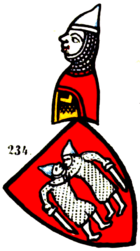
| Wikimedia Commons has media related to Human figures in heraldry. |
- Soldiers, armed men
- Two armed men in combat, for Manesse (Zürich armorial, c. 1340)
- A Cossack appears in the arms of Cherkasy, Ukraine.[3]
- Cossack with musket
- Rider
- Saint George and the dragon
- Pahonia
- A pilgrim (St Fridolin) for Glarus
- Wild men
- for Klosters and the League of Ten Jurisdictions (16th century)
- Virgin and Child with Saint Anne for Annaberg-Buchholz (1501)
- A maid holding a wreath, for Magdeburg
- A child (later also a Moor or Turk) being devoured by the Biscione (serpent), for Visconti of Milan
- A crowned Moorish queen for the counts of Kirchberg, Swabia (13th century), hence the municipal arms of Illerkirchberg
Parts of human bodies
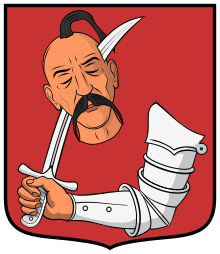
- The head
- The hand, or hand and arm, is the most common part of the human body to be a charge.[1]
- The ear[4]
- Feet[5]
- (human) foot sole[6]
 Example of a foot (sole) being used as a heraldic charge in the coat of arms of the Voet family (16th century)
Example of a foot (sole) being used as a heraldic charge in the coat of arms of the Voet family (16th century)
- Teeth
- Tongue[7]
- The heart, even when blazoned "a human heart", always appears like the heart in a deck of cards rather than a natural human heart.
- A "dug" or woman's breast "distilling drops of milk" famously appears in the arms of the Dodge family, and appeared for a time on the badge of cars made by the Dodge Automotive company.[8]
- Beards[9]
- Testicles: the Neapolitan family of Coglione bore per fess argent and gules, three pairs of testicles counterchanged.[10] The similar coat of the Counts Colleoni of Milan is sometimes blazoned Per pale argent and gules, three hearts reversed counterchanged.[11]
Beasts
Any animal can be a heraldic charge, although more traditional ones vary in the exactitude with which they resemble the creature as found in nature. Animals depicted naturally are either described as natural or using the scientific nomenclature.
Predatory beasts

- Felines
- The lion.
- The heraldic tyger is an imaginary monster; where the natural beast appears it is blazoned as a Bengal tiger.[1][12]
- A leopard refers to a lion "passant guardant", rather than a natural leopard, in the languages of French and English heraldry. A leopard's face also occurs, sometimes jessant-de-lys.[1]
- A heraldic panther is usually depicted spitting fire
- The (domestic) cat, distinguished from the wild cat or "cat-a-mountain"
- Canines
- Fox
- Hound (dog). The two most common breeds are the talbot (dog) and greyhound.[1]
- Wolf
- Bear
- Brock or (badger)
- Weasels such as the Ermine (stoat)
- Otter[1]
- Thylacine
Ungulates
- Antelope, usually blazoned as a specific type unless it is the mythical heraldic antelope.
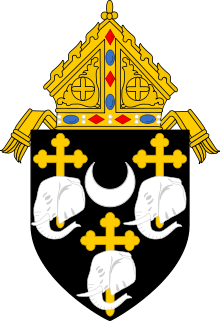 Elephant head's as charges on the arms of the Diocese of Camden.
Elephant head's as charges on the arms of the Diocese of Camden. - Cattle Bulls, cows or calves.
- Camel
- Deer usually a red deer, also called a hart or Stag, and the Buck denotes a Fallow deer. Females are called hinds or does.[1]
- Elephant; sometimes with a Howdah or castle on its back[15]
- Equines such as the ass and the horse sometimes of a specified breed and the unicorn[1] and Pegasus.
- Hippopotamus
- Rhinoceros
- Swine either wild boars or domestic pigs
- Sheep and Goats Including Rams, ewes, lambs, ibex and Agnus Dei
Other mammals
Reptiles and amphibians
- The serpent usually depicted nowed.[1]
- The salamander is typically shown as a generic lizard, sometimes with a head of unusual shape often described as "dog-shaped", and always surrounded by flames.
- The lizard
- The Biscione
- Dragon: by default a European one, but also a Chinese dragon.[18]
- Tortoises and Turtles
Insects
Insects include:
- Bee, often flying around beehives, natural or man-made
- Butterfly
- Dragonfly
- Emmet (heraldry)
- Flea
- Fly
- Grasshopper
Hybrids

- Sphinx: depicted with the head and breasts of a woman.
- Griffin, combining the head (but with ears), chest, wings and forelegs of the eagle with the hindquarters and legs of a lion (the male griffin lacks wings and his body is scattered with spikes). See List of griffins as mascots and in heraldry.
- Unicorn, having a horse's body, deer's legs, goat's beard, and often a lion's tail
- The hippogriff is like the griffin except that the lion parts of the griffin are replaced by those of a horse.
- Harpy
- Theow is a wolf-like creature but with cloven hooves.
- The "sea-horse" (hippocampus) is depicted as half horse and half fish
- The sea-lion is a combination of a lion and a fish.[1]
- Any combination of parts of other animals, e.g. winged reindeer, is possible.[1]
Birds
By far the most frequent heraldic bird is the eagle. A variant is the alerion, without beak or feet, seen in the arms of the duchy of Lorraine (of which it is not quite an anagram).
Also very frequent is the martlet, a conventional swallow depicted without feet or the French variant the merlette, which also omits the beak.
- Auk[19]
- Avalerion
- Cock
- Cockatoo
- Cormorant
- Corvus
- Crane
- Dove
- Duck without beak or legs is called the merlette
- Eagle, usually displayed, i.e. with wings spread
- Alerion: eagle without beak or feet
- Double-headed eagle
- Triple-headed eagle
- Golden eagle#Heraldry and myth
- Eagle of Saladin, a symbol associated with secular Arab nationalism, contrasted with the Hawk of Quraish
- Emu
- Falcon
- Garuda
- Goose
- Gull or seagull
- Hawk
- Hawk of Quraish, a symbol associated with political Islam and Arab monarchy, contrasted with the Eagle of Saladin
- Heron
- Kiwi
- Kookaburra
- Magpie: Otton de Cazeneuve bore "Or, three magpies sable" at Falkirk.
- Martlet
- Osprey: almost invariably depicted simply as an eagle argent, often maintaining (holding in its talons or beak) a fish
- Ostrich or its feathers
- Owl
- Papingo or Popinjay (parrot).
- Pelican, sometimes with its young.[20]
- When a pelican is blazoned as "vulning", it refers to a pelican injuring herself, while a pelican "in her piety" refers to a female pelican feeding her young with her own blood.[21]
- Peacock often blazoned in its pride
- Phoenix
- Stork[22]
- Swan
- Turkey cock: was a later immigrant from the New World
- Turul
- Egg: rare.
Fish and creatures of the sea
"Fish" are sometimes only described as "a fish", but the species is often named:
- Carp
- Catfish[23]
- Cod
- Conger
- Cuttlefish
- Dolphin[1]
- Eel
- "Garvine fishes", in canting contexts[24]
- The pike, also called a ged or Lucy[1]
- Perch
- Roach
- Salmon
- Sturgeon
- Herring
- The seahorse is depicted as half horse and half fish, but if the natural seahorse is to be depicted it is blazoned as a "seahorse (hippocampus)".
- The whale[1]
- The escallop (scallop shell)
- Mullet
- Mussels appear in the arms of Musselburgh in Scotland.[1]
- Whelk shell
- Mermaid and Melusine
- Mahseer - used in Indian Muslim heraldry, such as the coat of arms of Bhopal State, Kurwai State, or the Kingdom of Oudh. See Mahseer in heraldry.
- Octopus
- Squid
Parts of animals
Parts of creatures may also be used as charges.
Plants
Flowers
.svg.png)
- The fleur-de-lis
- Heraldic roses are shown in a stylised form similar to the wild rose. A rose on top of another rose form a double rose.
- though there are several unusual different types blazoned, such as the Luther rose.
- White Rose of York; Red Rose of Lancaster; Tudor Rose, which is a double rose.
- The lotus flower
- The thistle
- Other commonly used flower-like charges (called "foils") include:
- Trefoil (with three petals; usually slipped, with a stem)
- Quatrefoil (with four petals)
- Cinquefoil (with five petals)
- Sexfoil (with six petals)
- The septfoil (with seven petals)
- The double quatrefoil (with eight petals)—in England the rare cadency mark of a ninth son.
- Strawberries and the strawberry flowers depicted as cinquefoils
- Tulips
- Grapevines
Trees and their fruits
Trees appear as eradicated (showing the roots) or couped. Fruit can appear on a tree, or by itself. Also, leaves and branches appear.
Other flora
- Maple leaf - symbol of Canada

Trees are sometimes merely blazoned as "a tree" but specific trees are mentioned in blazon.
- The oak and the acorn
- The pines and the pine-cone also called a pineapple.
- Elm
- Poplar, also called aspen
- Willow, also called Salix or Osiers; its branch is called a wand
- Alder
- Coconut tree
- Palm
- Laurel trees
- Olive
- The pomegranate tree
- Cannabis
- Grass, often on a mound
- Seeblatt
A small group of trees is blazoned as a hurst, grove, wood or thicket.[2]
Grain crops and vegetables
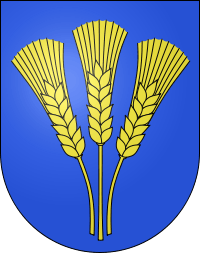
Inanimate charges
Regarding "inanimate objects", Fox-Davies (1909:281) comments:
- "one can safely say that there is scarcely an object under the sun which has not at some time or other been introduced into a coat of arms or crest. One cannot usefully make a book on armory assume the character of a general encyclopedia on useful knowledge, and reference will only be made in this chapter to a limited number, including those which from frequent usage have obtained a recognised heraldic character."
Crosses
Originally representing the Christian cross used as field sign and standard during the Crusades, heraldic crosses diversified into many variants in the late medieval to early modern period, the most common (besides the plain "Greek cross") being the cross potent, cross pattée, cross fleury, cross moline, cross crosslet (etc.).
Lettering
| Wikimedia Commons has media related to Letters in heraldry. |
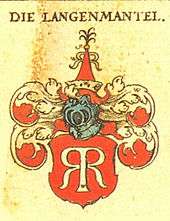
Lettering in coats of arms are usually placed in the motto, not in the heraldic shield as a charge. However, a tradition of introducing individual letters as heraldic charges on the basis of acrophony originates in the 15th to 16th century, primarily in personal and municipial heraldry, and with some frequency in the modern period, appearing more often on the continent than in British heraldry where letters as charges have traditionally been discouraged. Fox-Davies (1909:281) regarding letters of the alphabet as heraldic charges:
- "Instances of these are scarcely common, but the family of Kekitmore[30] may be adduced as bearing 'Gules, three S's or,' while Bridlington Priory had for arms 'Per pale, sable and argent, three B's countercharged.' [...] Corporate arms (in England) afford an instance of alphabetical letters in the case of the B's on the shield of Bermondsey."
One of the earliest instances of the use of letters as heraldic charges is that of the Langenmantel family of Augsburg. Rüdiger I Langenmantel (d. 1342), one of the leading figures of the Augsburg patriciate during the first four decades of the 14th century, is the founder of the "Langenmantel vom RR" branch of the family, derived from his coat of arms showing two letters R (for his given name), shown addorsed (as mirror images).[31]
Religious symbolism:
Nature
- A sphere[33] in an orbit.
- A sun with rays is called a sun in splendour.
- The Moon
- Crescents
- Also "in her plenitude" (a full moon with a face).
- Stars
- Mullets represent stars or spur rowels. Stars can have any number of points, but if nothing is specified in the blazon it is usually five or six.
- Estoiles are stars with wavy rays; pole stars are differentiated.
- Magen David
- Constellations such as the Southern Cross.
- Astrological symbols such as Taurus
- clouds
- An atomic cloud[34]
- A cumulo nimbus cloud [sic] in the arms of the 362d Fighter Group of the United States Air Force[35]
- A stylized cloud formation in the arms of the 23rd Air Division of the United States Air Force
- A tornado in the arms of the 311th Fighter Group of the United States Air Force[36]
- The planets such as Jupiter and Saturn. Also representing metals (Mars for iron, Venus for copper, Saturn for lead)
- The armillary sphere or globe[2]
- Lightning bolts, also called "lightning flashes", are shown in a stylized way.
- Thunderbolts, shown in a stylized way
- volcano
- A mount (mountain, hill hillock). A mount with three tops is known as trimount, for mounts with more than three tops, the number of tops is blasoned as coupeaux (as in, a mount with six coupeaux). When the mount is included in the lower part of the shield, it may be considered an ordinary rather than a charge.
Ships and boats
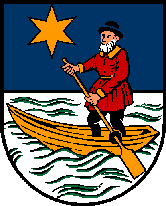
Structures
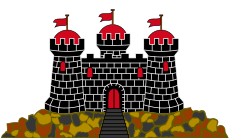
- Religious Structures
- Fortified buildings
- Castle, a castle of the generic type consists of two towers connected by an embattled wall (also a charge in heraldry).[1] Varieties occur, such as being triangular or quadrangular. Also, the windows and doors can be of a different tincture, as well as the masonry. Sometimes they have domed towers.
- Towers can be combined with castles or have their own towers. They vary in the same way as castles.
- Portcullis[1]
- Columns
- Arches
- Mills, e.g. windmills[1]
- Dovecotes
- Tents[20]
Headgear
- Phrygian cap
- Mitre[2]
- Crowns or coronets, if not more precisely specified, have four leaves (three visible) and no arches. Varieties include:
- naval crown[2]
- Royal Crown
- Imperial crown
- civic crown[2]
- Eastern crown or Antique crown[2]
- camp crown, crown vallary or crown palisado[2]
- mural crown[2]
- Crancelin, a crown of rue[2]
- Papal tiara
- Helmets
Music
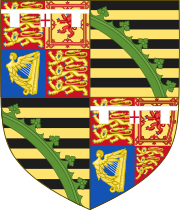
Musical instruments include:
Weapons
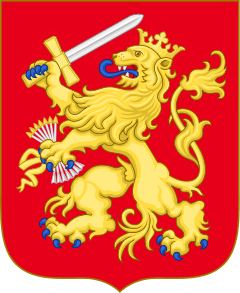
- Axes of various types
- Battering ram[20]
- Bow, including the longbow and crossbow, and arrow[2]
- Caltrop, displayed with one spike pointing upwards
- Cannon, including the culverin[1]
- Grenade: similar in appearance to a cannonball with flames coming out of a flattened end.[1]
- Lance and spear sometimes broken, usually of the tilting variety.[2]
- Mace[2]
- Musket[40]
- Sword, including variants such as the scimitar, seax, and dagger[1]
- Pennon, often referred to as a pile (military construction beam) or passion nail (tool); a type of flag used to signal battle commands.[41]
Tools
- Anvil[1]
- Fetterlock[1]
- Fire brand[1]
- Fire striker[1]
- Fleam[1]
- Hammers, of various types[1]
- Harrow[20]
- Keys[1]
- Millrind[1]
- Nails, often passion nails (Arma Christi)[1]
- Shovel
- Sickle
- Ladders typically take the form of scaling ladders.[1]
- Rake
- Scales (weighing)
- Shuttle[1]
- Surgeons' scalpels
- Trowel
- Tun[20]
- Water-bougets A charge resembling the water bags that were used to supply the army in battle[20]
Clothing and other personal items
Other
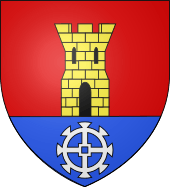
- A glass throughout, shattered, argent[45]
- The wheel is a carriage wheel unless otherwise specified
- A winged wheel
- Catherine Wheel
- A millwheel or water wheel
- Cogwheel (used mainly in more recent coats-of-arms to represent heavy industry)
- The Japanese mon emblem has been used as heraldic charge in recent heraldry. It is blazoned in traditional heraldic style rather than in the Japanese style. An example is the Canadian-granted coat of arms of David Tsubouchi (1993).[46]
References
- Fox-Davies, Arthur Charles (1909). A complete guide to heraldry (1909). New York : Dodge. Retrieved 2013-08-21.
- "Heraldsnet.org". Heraldsnet.org. Retrieved 2010-08-16.
- "Ukrainian heraldry".
- "L'Armorial".
- "Leg; Foot". Mistholme. Retrieved 2020-05-28.
- "Sole". Mistholme. Retrieved 2020-05-28.
- "NGW.nl". NGW.nl. Retrieved 2010-08-16.
- Martin Goldstraw. "Cheshire-Heraldry.org.uk". Cheshire-Heraldry.org.uk. Retrieved 2010-08-16.
- "Zeljko-heimer-frame.from.hr". Zeljko-heimer-fame.from.hr. Retrieved 2010-08-16.
- "Sex in Heraldry". Heraldica.org. 1997-06-26. Retrieved 2010-08-16.
- John Woodward and George Burnett, A Treatise on Heraldry, British and Foreign, page 203
- "NGW.nl". NGW.nl. Retrieved 2010-08-16.
- "Cenotillo - Escudo - Coat of arms - crest of Cenotillo". Retrieved 2018-05-13.
- "Heralrdy.ca". Heraldry.ca. Retrieved 2010-08-16.
- The coat of arms of the 64th Armor Regiment of the United States Army specifies, bizarrely, "the head of a fighting African elephant," though there should be no distinction made between this and the depiction of a default elephant.
- From "Jack of Naples" (Jac-a-Napes), later (early modern period) reanalyzed as "jack-an-apes", taking "apes" as "ape, monkey". Monkeys were one of many exotic goods from Naples exhibited in England, hence acquired the nickname Jack a Napes (first attested 1450).
- Charles Norton Elvin, Dictionary of Heraldry, 1889, plate 29, nos. 57–59. The monkey as heraldic animal remained comparatively rare, but it is on record from as early as the 14th century, as in the Affenstein crest from the Zürich armorial (c. 1340).
- "College-of-arms.gov.uk". College-of-arms.gov.uk. Retrieved 2010-08-16.
- "Heraldsnet.org". Heraldsnet.org. Retrieved 2010-08-16.
- Jacqueline Fearn. Discovering Heraldry. Shire Publications. pp. 40–41.
- Gough, Henry (1894). A Glossary of Terms Used in Heraldry. J. Parker. p. 451. Retrieved 19 August 2017.
- "NGW.nl". NGW.nl. Retrieved 2010-08-16.
- Gerard Michon (2004-06-19). "Numericana.com". Numericana.com. Retrieved 2010-08-16.
- Balfour Paul, James (1893). An Ordinary of Arms Contained in the Public Register of All Arms and Bearings in Scotland. William Green and Sons. pp. 108–109.
- "Heraldsnet.org". Heraldsnet.org. Retrieved 2010-08-16.
- "College-of-arms.gov.uk" (PDF). Retrieved 2010-08-16.
- Morant, Alfred William W. (2006-06-12). Books.Google.com. Retrieved 2010-08-16.
- "The FAME: Varazdin County - Communities". Retrieved 2018-05-27.
- "College-of-arms.gov.uk" (PDF). Retrieved 2010-08-16.
- John Guillim, A Display of Heraldry (1780), p. 295.
- Ernst Heinrich Kneschke, Neues allgemeines deutsches Adelslexikon, vol. 5, Leipzig, (1864),388f.
- A Complete Guide to Heraldry by A.C. Fox-Davies and J.P. Brook-Little (1969 edition), p. 212.
- In the arms of the 91st Bombardment Group of the United States Air Force.Air Force Combat Units of World War II. p. 158.
- Shown in the coats of arms of several units of the United States Air Force, such as the 508th Fighter Group.Air Force Combat Units of World War II. p. 371.
- Air Force Combat Units of World War II, p.246
- Air Force Combat Units of World War II. p. 187.
- Cundinamarca.gov.co
- Heraldsnet.org
- Heraldica.org
- Heraldsnet.org
- Journal of the British Archaeological Association, Volume 13. British Archaeological Association., 1857 - Archaeology, Page 119
- Balfour Paul, p. 41
- Heraldica.org
- "Weald and Downs Area". Civic Heraldry. Retrieved 16 August 2019.
- Air Force Combat Units of World War I, p.154
- Tsubouchi, David Hiroshi (Individual), Public Register of Arms, Flags, and Badges of Canada
- Fox-Davies, Arthur Charles , A complete guide to heraldry (1909).
External links
- NGW.nl, List of heraldic charges (with images)
- A Heraldic Primer, SCA College of Arms on the Web
